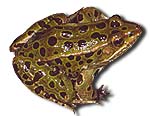
Rana
pipiens
(Northern Leopard Frog)

Key Characteristics:
|
Adult Characteristics |
Tadpole Characteristics |
Egg Characteristics |
|
Pigmented |
||
|
Dark blotches |
Eyes set in from |
|
| . | ||
|
Tail fin translucent |
. |
General
Description:
Northern
Leopard Frogs are medium sized reaching sizes up to 100mm (4 in.).
They are easily recognized by the dark
spots that are surrounded by light colored halos. Their ground color
is usually some shade of green or brown.
Northern Leopard Frogs have a white ventral coloration. Additional distinguishing
characteristics are the prominent dorsolateral![]() ridges found running from behind the eye to the groin and the readily visible
tympanum. Males will congregate and produce a chorus described as a guttural
ridges found running from behind the eye to the groin and the readily visible
tympanum. Males will congregate and produce a chorus described as a guttural![]() chuckling. The males will actually produce three distinct calls
with varying sounds (see Nussbaum et al. 1983).
chuckling. The males will actually produce three distinct calls
with varying sounds (see Nussbaum et al. 1983).
Northern Leopard Frog tadpoles are similar, although smaller, than Bullfrog tadpoles, reaching sizes of around 85mm (3.3 in.). Northern Leopard Frogs tadpoles lack the black specks of Bullfrog tadpoles, having metallic flecks on a brown dorsal color instead. Ventrally, Northern Leopard Frog tadpoles are translucent with the intestines readily visible.
Northern Leopard Frog eggs are small (1.5mm or 1/25 in.) in diameter and are laid in flattened spherical clusters. Each clutch can contain up to 6,000 eggs. Multiple females may lay clutches in the same area as evidenced by the photo.
Idaho
Distribution:
In Idaho, Northern Leopard
Frogs are found throughout much of the southern part of the state, following
the Snake River Plain. Populations also exist in the northern portion
of the panhandle.
From Great Slave Lake and Hudson Bay, Canada, south to Kentucky and New Mexico. Introduced in number of localities in western states.
Habitat:
Northern Leopard
Frogs are generally associated with heavily vegetated marshes, ponds,
streams etc. Likewise, they seem to breed in areas that are also heavily
vegetated. In Idaho, they may be found in or around ponds, lakes and marshes
Diet:
Metamorphosed frogs eat various
small invertebrates obtained along water's edge or in nearby meadows or fields.
Adults rarely eat small vertebrates, although in Idaho, northern leopard frogs
are known to eat birds, garter snakes, tadpoles, small frogs, and fishes, as
well as snails, leeches, spiders and small insects. Larvae eat algae, plant
tissue, organic debris, and probably some small invertebrates.
Ecology:
Probably hibernates![]() in streams, ponds or other aquatic locations in winter. Disperses to moist uplands
or permanent water during dry-up in summer. Requires moderately high ground
cover for concealment. Preyed upon by garter snakes. When disturbed, these frogs
leap rapidly and erratically. Anecdotal information exists for their decline
in Idaho.
in streams, ponds or other aquatic locations in winter. Disperses to moist uplands
or permanent water during dry-up in summer. Requires moderately high ground
cover for concealment. Preyed upon by garter snakes. When disturbed, these frogs
leap rapidly and erratically. Anecdotal information exists for their decline
in Idaho.
Reproduction:
Lays clutch of up to several
thousand eggs from March to June, depending on range (in Idaho, breeding activity
begins in March or April, when water temperatures reach 10° C). Aquatic larvae
usually metamorphose in summer, but may overwinter in some areas. In most areas,
adults reach sexual maturity in 2 yr.
Conservation:
|
Status: |
Unprotected nongame species |
|
Global Rank: |
|
|
State Rank: |
S3 |
Important
State Reference:
Groves, C.R. and C. Peterson.
1992. Distribution and population trends of Idaho amphibians as determined by
mail questionnaire. Idaho Dept. Fish & Game, Boise. 16pp.